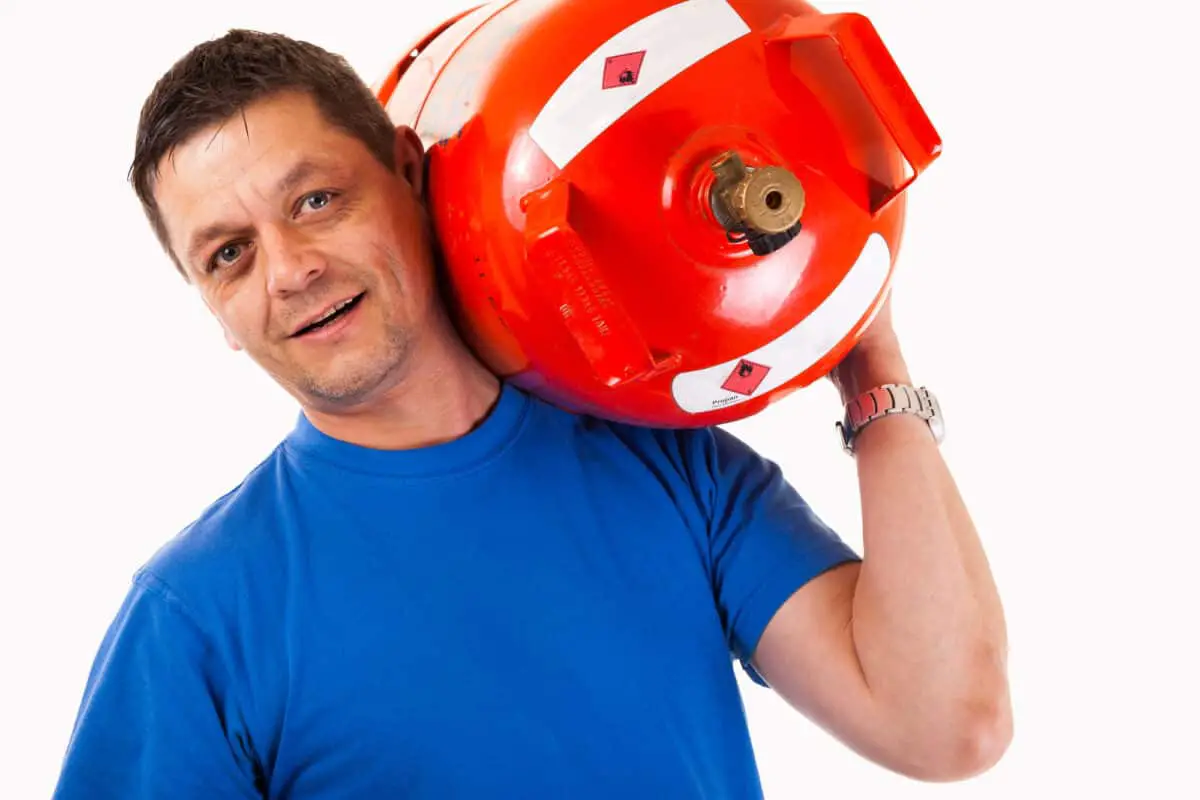The propane tank longevity will depend on several factors, such as the size of the tank, the BTUs of the patio heater, and the area you want to heat up.
A 20-pound propane tank can provide approximately 10 hours of heat for patio heaters.
Propane-powered patio heaters require low maintenance, can be portable or permanent, and come equipped with safety features.
If you’re planning to use a propane tank to power up your patio heater for the first time, it’s important to know how long the fuel will last.
Most patio heaters are designed to be used with a standard 20-pound propane tank and are capable of generating approximately 40,000 BTUs of heat.
Here is a rough estimate of how much your patio heater will cost to run based on various factors.
Related Reading: How To Tell If Your Propane Tank Has Expired

Related Reading: Can You Convert a Propane Heater to Natural Gas? [ANSWERED]
Table of Contents
A 20-pound Propane Tank Longevity
A 20-pound propane tank provides approximately 4.7 gallons of fuel and has an average lifespan of 10 hours.
You can power up your patio heater for 9 to 15 hours with a single propane tank, allowing you to keep your patio warm for multiple evenings. It typically costs between $15 and $20 to fill a propane tank.
When you calculate the cost of using propane for your patio heater, you’ll find that it only costs between $1.50 and $2.00 per hour of use.
This is why using patio heaters powered by propane tanks is one of the most cost-effective methods for heating outdoor patios. It is important to know the propane tank longevity to figure out the savings.
While they can withstand rain, they are not necessarily waterproof and may experience wear and tear from the elements.
Related Reading: Should You Use an Outdoor Patio Heater in the Rain?
Related Reading: Are Patio Heaters Waterproof? | Avoid a Damaged Unit
Benefits of Using a Propane Tank for Heaters
There are various fuel sources available for patio heaters, including electric, propane, and natural gas.
Propane-fueled patio heaters offer numerous benefits over other options, making propane tanks a popular choice.
Setting up the propane tank is easy with minimal maintenance required. You can complete the task at hand and then unwind without any distractions.
You can purchase both permanent and portable styles of propane tanks. It’s important to review your requirements and select the best option.
If you’re using a portable patio heater, the propane tank can fit inside the base for easy installation.
The software comes with several built-in security features, ensuring safety at all times.
You can use propane gas without worrying about any harm to soil or water as it is non-toxic.
If you’re concerned about installing the propane tank yourself or if you’re new to using propane patio heaters, it’s always a good idea to have a professional install it for you.
This will save you time and worry, and they can even give you a demonstration on how to properly light it.
Patio Heater Safety Tips
While propane tank longevity is beneficial for your patio heater, it’s important to note the associated safety risks.
You can minimize the chances of facing safety risks while using a propane tank by having a clear understanding of them.
You should take special care when handling your propane tank to avoid damaging the valves.
When handling a propane tank, it’s important to follow the manufacturer’s instructions for proper care and cleaning.
You should carefully read the manufacturer’s instructions before using your propane tank to ensure your safety.
You must adhere to these instructions for the safe installation, transportation, and filling of the propane tank.
You should inspect all hoses and connections when using propane.
To avoid any issues, it’s important to be able to detect potential problems with your propane tank.
Additionally, it’s important not to overfill your tank with fuel as this can significantly increase the associated risks.
By taking these precautions, you can help minimize the overall risk of any accidents or issues.
A lot of hardware stores and even gas stations offer full-service propane refills.
The propane tank must always be stored upright in a cool, dry outdoor location.
The propane tank storage area must be well-ventilated. Precautions must be taken when using it under a covered patio or deck.
Related Reading: Stay Warm with a Heater Under a Covered Patio: Your Ultimate Guide
Safe Storage of Propane Tanks
As previously mentioned, a single propane tank can only power a patio heater for an average of 10 hours.
If you need more propane, it’s important to store additional tanks safely.
It is important to maintain a distance of at least 20 feet between two propane tanks.
This ensures that the tanks do not come into contact with each other during the heat generated by the heater.
By maintaining an appropriate distance between the tanks, you can prevent any potential hazards that may arise due to improper placement. You can also refrain from experiencing an explosion or a fire.
The pressure inside a propane tank decreases as the temperature drops.
This can create a negative impact on the performance that is delivered to you out of the propane tank.
Investing in a pressure regulator is highly recommended to ensure proper functioning of your equipment.
The pressure regulator ensures consistent pressure in your propane tank, maximizing efficiency.
Propane Tank Regulator with Gauge
Final Words
Ensure that you purchase enough propane tanks to meet your needs when using them to power up a patio heater. Knowing the propane tank longevity will also help in your decision.
Then, you can always get an uninterrupted experience while using the propane tank.
You will be provided with all the support to enjoy the time spent on the patio during the colder months of the year.
Enjoy living the outdoor life!!!
Continue Reading:
